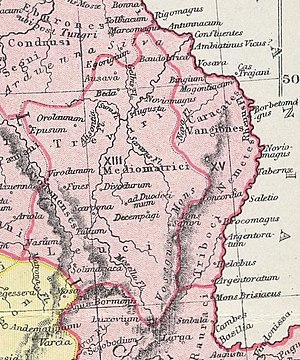Nemetes

The Nemetes (occasionally Nemeti[1]) were a tribe settled along the Upper Rhine by Ariovistus in the 1st century BC. Their capital, Noviomagus Nemeton (or Civitas Nemetum), was close to the site of medieval Speyer.[2]
Their area of settlement was the contact zone between Celtic (Gaulish) and Germanic peoples. According to Tacitus, the Nemetes were "unquestionably Germanic".[3] The name of the tribe, however, is Celtic as the name of its main town Noviomagus meaning noviios 'new' and magos 'plain', 'market' (cf. Welsh maes 'field', Old Irish mag 'plain'),[4] as are those of several gods worshipped in their territory, including Nemetona, who is thought to have been their eponymous deity.[5] Both of these names are taken to be derivations from the Celtic stem nemeto- "sacred grove".[4][5] [6]
In De Bello Gallico, Caesar writes that the Hercynian Forest "begins at the frontiers of the Helvetii, Nemetes, and Rauraci, and extends in a right line along the river Danube to the territories of the Daci and the Anartes".[7] Their territory on the left bank of the Rhine had belonged to the Mediomatrici during the time of Caesar and Strabo, but the Nemetes must have crossed the river and settled there sometime afterward.[8] Under the Roman administrative organization of Gaul, the Nemetes constituted a civitas of the province of Upper Germany with a relatively small territory extending from the Rhine into the Palatinate Forest and an administrative centre at Speyer. Ptolemy mentions Neomagus (i.e. Noviomagus) and Rufiniana as the towns of the Nemetes;[9] if the latter is to be identified with Rouffach, Ptolemy is mistaken in attributing it to the Nemetes, for Rouffach is far to the south in Rauracan territory.[10][11] It may also be supposed that Saletio (Seltz) belonged to the Nemetes, as in modern times it belonged to the diocese of Speyer; Saletio would have been near the northern limits of the Triboci, whose civitas later became the diocese of Strasbourg.[12] The Nemetes fought alongside the Romans and Vangiones against the Chatti when the latter invaded in 50 AD.[13]
The name of the Nemetes has been suggested, on contestable grounds,[14] as a possible source of the term for Germany and German people in Romanian: nemți/neamț, Hungarian: német(ek) and the Slavic languages (Russian: немцы nyemtsy, Polish: Niemcy, Czech: Němci).[15]
See also[]
Notes[]
- ^ Nemeti is occasionally found in modern publications, by mistaken analogy with other tribal names of the 2nd declension. E.g. Frederick Kohlrausch "History of Germany. From the Earliest Period to the Present Time". D.Appleton and Company, New York, 1880. p. 40.
- ^ Civitas Nemetum was destroyed in the 5th century, and Villa Spira was a Frankish settlement established in the 7th century outside the confines of the ancient settlement. Both are within the confines of the modern city of Speyer.
- ^ Tacitus. Germania 28.
- ^ a b Xavier Delamarre (2003). Dictionnaire de la langue gauloise. Éditions Errance, p. 233.
- ^ a b John T. Koch (2006). Celtic Culture: A Historical Encyclopedia. ABC-CLIO, p. 1351.
- ^ X., Delamarre (2003). Dictionnaire de la langue gauloise : une approche linguistique du vieux-celtique continental (2e éd. rev. et augm ed.). Paris: Errance. pp. 233–234. ISBN 9782877723695. OCLC 354152038.
- ^ C. Iulius Caesar, Commentarii de Bello Gallico, VI:25. Translation based on W. A. McDevitte and W. S. Bohn (1869), cf. Latin text.
- ^ George Long. "Mediomatrici", from Smith's Dictionary of Greek and Roman Geography.
- ^ Claudius Ptolemaeus. Geographia, II:8.
- ^ George Long. "Rufiniana", from Smith's Dictionary of Greek and Roman Geography.
- ^ In fact, the mistake comes from more modern historians, because Rufiniana cannot be the former name of Rouffach. It is impossible for three reasons : 1 - The ancient forms of this place-name are known as Rubiaco en 662, Rubac 912, Rubiacum 12th. 2 - The end of Rufiniana supposes two suffixes -ini(us?)-ana and Rubiaco has only one -aco. 3 - The first element Ruf- cannot change to [b] into Latin Rub-. On the contrary, the shift from [b] to [p] and finally to [f] (Rubac > *Rupach > Rouffach) is the typical result of the High German consonant shift, that took place a long time after Ptolemy's death.
- ^ George Long. "Triboci", from Smith's Dictionary of Greek and Roman Geography.
- ^ Tacitus. Annals, XII: 27.
- ^ "nêmьcь". Denkschriften der Kaiserlichen Akademie der Wissenschaften, Band 15. Philosophisch-Historische Klasse, Österreichische Akademie der Wissenschaften, Wien, 1867. (in German)
- ^ The Journal of Indo-European studies 1974, v.2 Etymology of the Polish-language word for Germany Archived 2008-04-02 at the Wayback Machine (in Polish)
External links[]
- Historical Celtic peoples
- Early Germanic peoples
- Gauls
- Tribes of pre-Roman Gaul